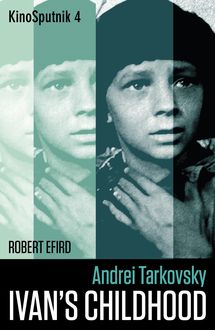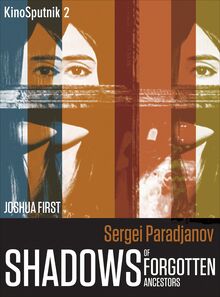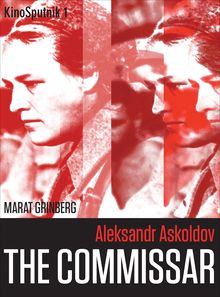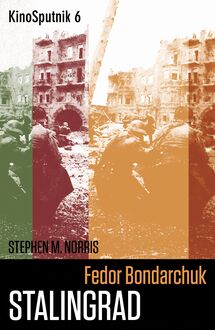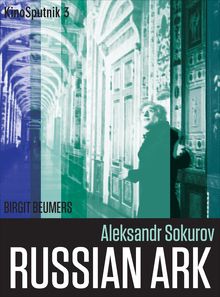-
 Univers
Univers
-
 Ebooks
Ebooks
-
 Livres audio
Livres audio
-
 Presse
Presse
-
 Podcasts
Podcasts
-
 BD
BD
-
 Documents
Documents
-
- Cours
- Révisions
- Ressources pédagogiques
- Sciences de l’éducation
- Manuels scolaires
- Langues
- Travaux de classe
- Annales de BEP
- Etudes supérieures
- Maternelle et primaire
- Fiches de lecture
- Orientation scolaire
- Méthodologie
- Corrigés de devoir
- Annales d’examens et concours
- Annales du bac
- Annales du brevet
- Rapports de stage
La lecture à portée de main
Vous pourrez modifier la taille du texte de cet ouvrage
Découvre YouScribe en t'inscrivant gratuitement
Je m'inscrisDécouvre YouScribe en t'inscrivant gratuitement
Je m'inscrisEn savoir plus
Vous pourrez modifier la taille du texte de cet ouvrage
En savoir plus

Description
Note on transliteration
Acknowledgements
KinoSputniks general editors’ preface
List of illustrations
Production credits
Plot summary
Chapter 1: Introduction and production history
Chapter 2: Contexts
Chapter 3: Film analysis
Chapter 4: Themes and motifs
Chapter 5: Reception
Conclusion: The sinking ship
Sujets
Informations
| Publié par | Intellect Books |
| Date de parution | 10 novembre 2016 |
| Nombre de lectures | 0 |
| EAN13 | 9781783207053 |
| Langue | English |
Informations légales : prix de location à la page 0,1300€. Cette information est donnée uniquement à titre indicatif conformément à la législation en vigueur.
Extrait
First published in the UK in 2016 by
Intellect, The Mill, Parnall Road, Fishponds, Bristol, BS16 3JG, UK
First published in the USA in 2016 by
Intellect, The University of Chicago Press, 1427 E. 60th Street,
Chicago, IL 60637, USA
Copyright © 2016 Intellect Ltd
All rights reserved. No part of this publication may be reproduced, stored in a retrieval system, or transmitted, in any form or by any means, electronic, mechanical, photocopying, recording, or otherwise, without written permission.
A catalogue record for this book is available from the British Library.
Copy-editor: Michael Eckhardt
Cover designer: Emily Dann
Production manager: Matthew Floyd
Typesetting: Contentra Technologies
ISBN: 978-1-78320-703-9
ePDF: 978-1-78320-704-6
ePUB: 978-1-78320-705-3
KinoSputniks: Series Editors: Birgit Beumers & Richard Taylor Editorial Board: Julian Graffy, Denise Youngblood
Current titles: Aleksandr Askoldov: The Commissar by Marat Grinberg Sergei Paradjanov: Shadows of Forgotten Ancestors by Joshua First Aleksandr Sokurov: Russian Ark by Birgit Beumers
CONTENTS
Note on transliteration
Acknowledgements
KinoSputniks general editors’ preface
List of illustrations
Production credits
Plot summary
Chapter 1: Introduction and production history
Chapter 2: Contexts
Chapter 3: Film analysis
Chapter 4: Themes and motifs
Chapter 5: Reception
Conclusion: The sinking ship
References and select bibliography
Notes
Note on transliteration
The Library of Congress system has been used throughout, with the following exceptions: when a Russian name has an accepted English spelling (e.g. Tchaikovsky instead of Chaikovskii; Chaliapin instead of Shaliapin), or when Russian names are of Germanic origin (e.g. Eisenstein instead of Eizenshtein; Schnittke instead of Shnitke). I have also used the accepted spelling for Mariinsky (instead of Mariinskii) Theatre, and for the names of tsars or emperors (e.g. Nicholas instead of Nikolai; Alexander instead of Aleksandr). Where a source is quoted, the original spelling has been preserved.
Acknowledgements
I would like to thank May Yao, Jessica Mitchell and Matthew Floyd at Intellect Books for their enterprise in launching this new series of KinoSputnik, and I am hugely indebted to Richard Taylor, Denise Youngblood and Julian Graffy for their trust and support. My special thanks go to Nathalie Muller at Idéale Audience for allowing me to view Francofonia , and to Natal'ia Chertova in Moscow for her kindness and inspiration.
KinoSputniks general editors’ preface
This series intends to examine closely some key films to have emerged from the history of Russian and Soviet cinema. Continuing from KinoFiles (2000–2010), the KinoSputniks are intended for film enthusiasts and students alike, combining scholarship with a style of writing that is accessible to a broad readership. Each KinoSputnik is written by a specialist in the field of Russian and/or film studies, and examines the production, context and reception of the film, whilst defining the film’s place in its national context and in the history of world cinema.
Birgit Beumers & Richard Taylor Wales, June 2016
List of illustrations
1. The path of Custine and the camera.
2. Tilman Büttner and Aleksandr Sokurov on the shoot.
3. The Marquis de Custine (Sergei Dreiden).
4. Map of the Winter Palace and Hermitage complex.
5. Peter the Great, seen through internal windows.
6. Catherine the Great in the foyer of the Hermitage Theatre.
7. Custine in the Raphael Loggias.
8. Custine with Eliseev (left) and Khmel'nitskii (right) in the Small Italian Skylight Room in front of the Tintoretto painting.
9. Custine with Kurenkova in front of Madonna with Partridges .
10. Custine with Kurenkova in front of Feast in the House of Simon the Pharisee as they are quizzed by two sailors.
11. Custine corners the boy in front of El Greco’s Peter and Paul .
12. Custine and Alla Osipenko in front of Danaë .
13. Custine and the carpenter in the room with the coffin and empty frames (representing the Siege).
14. Nicholas I receives the Persian envoy’s apology.
15. Custine inspects the Sèvres porcelain.
16. Three consecutive directors of the Hermitage in the darkened Memorial Hall of Peter the Great.
17. Nicholas II en famille .
18. Gergiev conducting the Mariinsky Orchestra.
19. The great ball in Nicholas Hall.
20 & 21. The guests descend the Jordan Staircase.
22. The guard spouts air and Custine repeats the gesture as he exits a room.
23 & 24. The camera leaves through the Hermitage’s door onto the Neva.
25. The Louvre in Francofonia .
Production credits Russian title: Russkii kovcheg Producers: Andrei Deriabin, Jens Meurer and Karsten Stöter Production companies: Hermitage Bridge Studio [Ermitazhnyi Most] (St Petersburg) and Egoli Tossell Film AG (Berlin). Co-produced by NHK, Seville Pictures Inc., Kopp Media, WDR/arte, Fora Film, M and AST Studio. With the participation of The State Hermitage Museum; Ministry of Culture of the Russian Federation, Department of State Support for Cinematography; Mitteldeutsche Medienförderung; Filmboard Berlin-Brandenburg; Filmförderung Hamburg; Filmbüro Nordrhein-Westfalen; Kulturelle Filmförderung des Bundes; Kulturelle Filmförderung Sachsen-Anhalt; YLE/TV1; DR1; Seville Pictures Inc.; Studio Babelsberg; and Das Werk (Stephen Coppen). Release date: 2002 (UK: 4 April 2003) Director: Aleksandr Sokurov Screenplay: Aleksandr Sokurov, Anatolii Nikoforov; dialogue: Boris Khaimskii, Aleksandr Sokurov and Svetlana Proskurina UK distributor: Artificial Eye Director of photography: Tilman Büttner Sound mix: Dolby SR Aspect ratio: 1:1.85 Production design: Elena Zhukova and Natal'ia Kochergina Lighting: Anatolii Rodionov and Bernd Fischer Casting: Tat'iana Komarova Costume design: Lidiia Kriukova, Tamara Seferian and Mariia Grishanova Make-up: Liudmila Kozinets and Zhanna Rodionova Original music: Performed by State Hermitage Orchestra Music: Mikhail Glinka ( Life for a Tsar ), performed by the Mariinsky Theatre Orchestra and conducted by Valerii Gergiev Composer: Sergei Evtushenko, with arrangements from Glinka, Tchaikovsky, Purcell and Telemann Editing and Digital Imaging: Sergei Ivanov Sound: Vladimir Persov and Sergei Moshkov Choreographer: Galy Abaidulov Running time: 96 minutes
CAST Stranger/Custine Sergei Dreiden Catherine the Great Mariia Kuznetsova Spy Leonid Mozgovoi Mikhail Piotrovskii Himself Prince Orbeli David Giorgobiani Boris Piotrovskii Aleksandr Chaban Lev Eliseev Himself Oleg Khmel'nitskii Himself Alla Osipenko Herself Talented Boy Artem Strel'nikov Tamara Kurenkova Herself Peter the Great Maksim Sergeev Catherine the First Natal'ia Nikulenko First Lady Elena Rufanova Second Lady Elena Spiridonova Nicholas I Iulian Makarov [real name: Iurii Zhurin] Nicholas I’s wife Svetlana Svirko First Cavalier Konstantin Anisimov Second Cavalier Aleksei Barabash Third Cavalier Il'ia Shakunov Alexandra Fedorovna (Nicholas II’s wife) Anna Aleksakhina Nicholas II Vladimir Baranov Chancellor Nesselrode Boris Smolkin Master of Ceremonies Kirill Dateshidze Chamberlain Vadim Lobanov Persian Envoy Suren Vartanov Narrator Aleksandr Sokurov
SCREENINGS AT INTERNATIONAL FESTIVALS (AND AWARDS)
Cannes Film Festival, 2002
Karlovy Vary International Film Festival, 2002
Chicago International Film Festival, 2002
London International Film Festival, 2002
Pusan International Film Festival, 2002
Toronto International Film Festival, 2002 (Visions Award)
Sitges – Catalonian International Film Festival, 2002
San Francisco Film Critics Circle, 2003 (Critics’ Prize)
Málaga International Week of Fantastic Cinema, 2003 (Best Actor – Dreiden; Best Cinematography – Büttner; Best Director – Sokurov)
European Film Academy (EFA), 2002 (Nomination for Best Director and Best Cinematography)
NIKA Awards, 2003 (Best Production Design and Best Costume Design; nominations for Best Film and Best Sound)
German Camera Award, 2003 (Honourable Mention for Tilman Büttner)
Argentinian Film Critics Association Awards, 2004 (Silver Condor – Best Foreign Film)
Plot summary
An invisible man, disorientated and suffering from memory loss, and who speaks with Aleksandr Sokurov’s voice, finds himself outside the Hermitage some time in the nineteenth century. Inside the building, he meets a Stranger, modelled on the French diplomat Marquis Astolphe de Custine, who is also unsure about the time and place. Together, the visible Stranger and the invisible Narrator embark on a long walk through the space: a museum of art and an imperial residence.
Exploring the palace, the Marquis and Narrator engage in a conversation about Russia and the influence that European culture exerted on the country. They enter the Hermitage through a basement section, where they see Peter the Great beating one of his generals. They continue, emerging in the Hermitage Theatre, where an orchestra plays music for a dramatic performance watched by Empress Catherine the Great. The Marquis wanders through the rooms of the Hermitage, starting with the Raphael Loggias and continuing through the Small Italian Skylight Room, the Van Dyck and Rubens Rooms, the Room of Netherlands Art, the Tent Hall (also known as Tent-Roofed Room, or Room of Dutch Paintings) and the Rembrandt Room before being ushered out of the museum’s art collection into the Pavilion Hall, where he meets an elderly Catherine the Great in conversation with a group of children. Throughout this part of the journey, Custine is introduced by the Narrator to contemporary visitors of the museum: a doctor and an artist, a young boy, a blind woman, a dancer, and two sailors. Custine’s conversations with them reveal his arrogant attitude and negative views on Russia and her culture.
As they continue their journey through St George Hall, the Armorial Hall, the Concert Hall and Great Nicholas Hall, Custine passes through key episodes of Russian history, from Nicholas I’s rec
-
 Univers
Univers
-
 Ebooks
Ebooks
-
 Livres audio
Livres audio
-
 Presse
Presse
-
 Podcasts
Podcasts
-
 BD
BD
-
 Documents
Documents
-
Jeunesse
-
Littérature
-
Ressources professionnelles
-
Santé et bien-être
-
Savoirs
-
Education
-
Loisirs et hobbies
-
Art, musique et cinéma
-
Actualité et débat de société
-
Jeunesse
-
Littérature
-
Ressources professionnelles
-
Santé et bien-être
-
Savoirs
-
Education
-
Loisirs et hobbies
-
Art, musique et cinéma
-
Actualité et débat de société
-
Actualités
-
Lifestyle
-
Presse jeunesse
-
Presse professionnelle
-
Pratique
-
Presse sportive
-
Presse internationale
-
Culture & Médias
-
Action et Aventures
-
Science-fiction et Fantasy
-
Société
-
Jeunesse
-
Littérature
-
Ressources professionnelles
-
Santé et bien-être
-
Savoirs
-
Education
-
Loisirs et hobbies
-
Art, musique et cinéma
-
Actualité et débat de société
- Cours
- Révisions
- Ressources pédagogiques
- Sciences de l’éducation
- Manuels scolaires
- Langues
- Travaux de classe
- Annales de BEP
- Etudes supérieures
- Maternelle et primaire
- Fiches de lecture
- Orientation scolaire
- Méthodologie
- Corrigés de devoir
- Annales d’examens et concours
- Annales du bac
- Annales du brevet
- Rapports de stage
